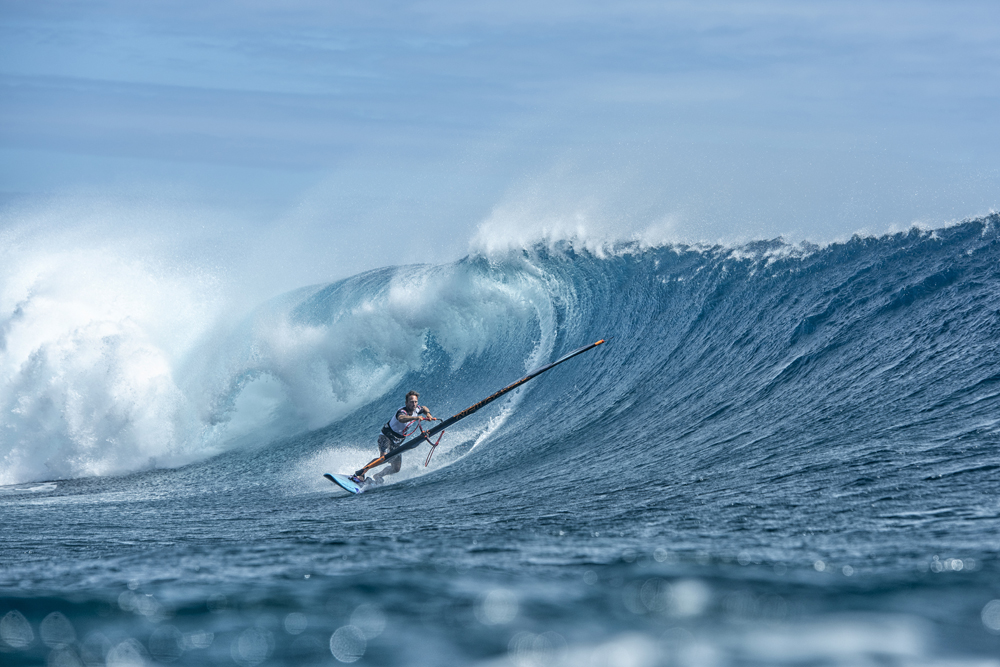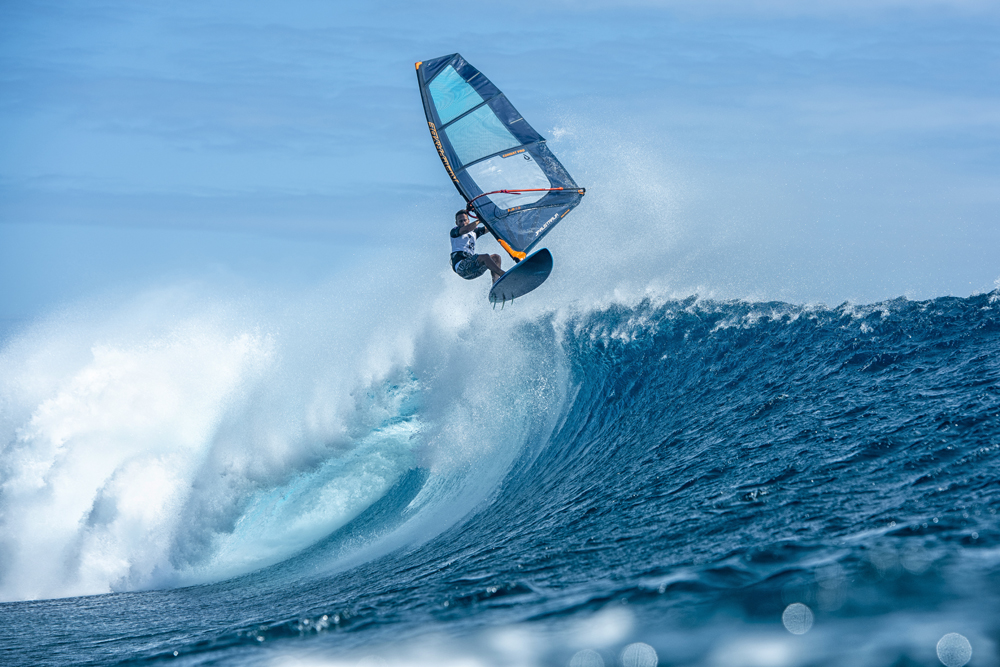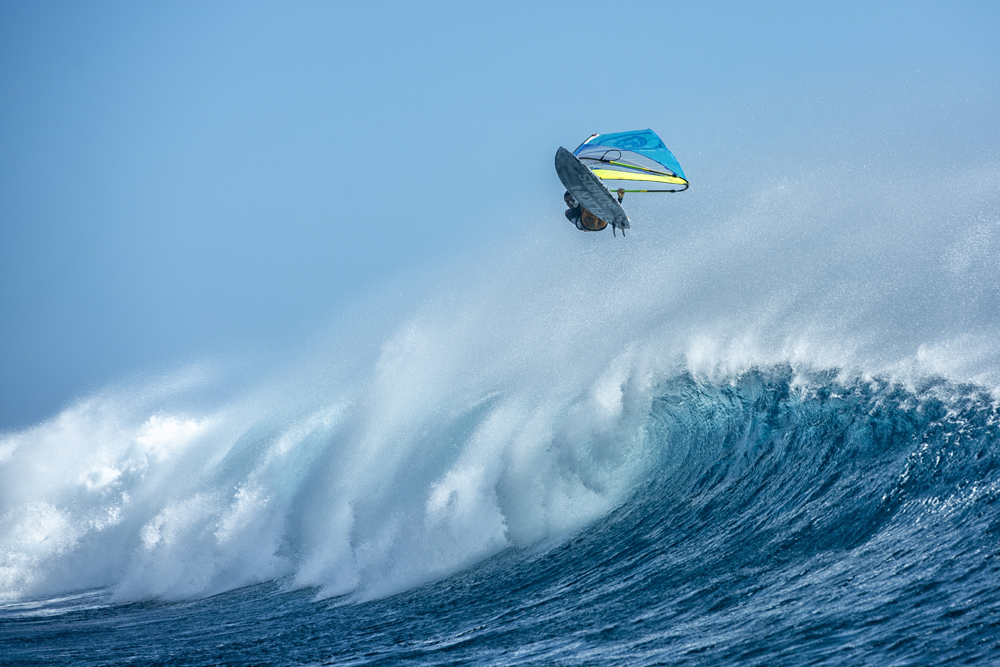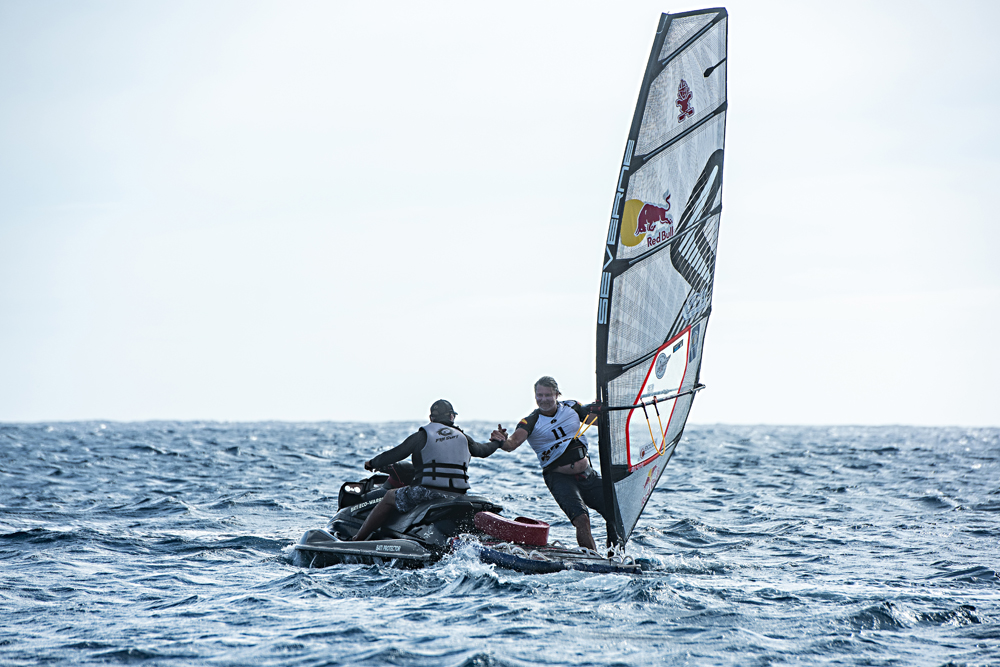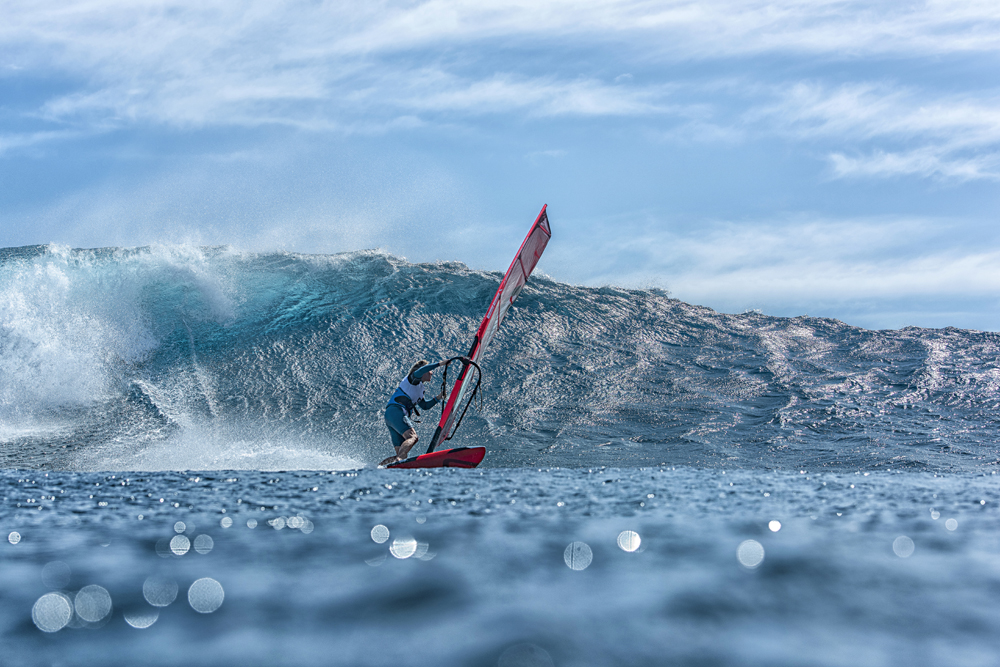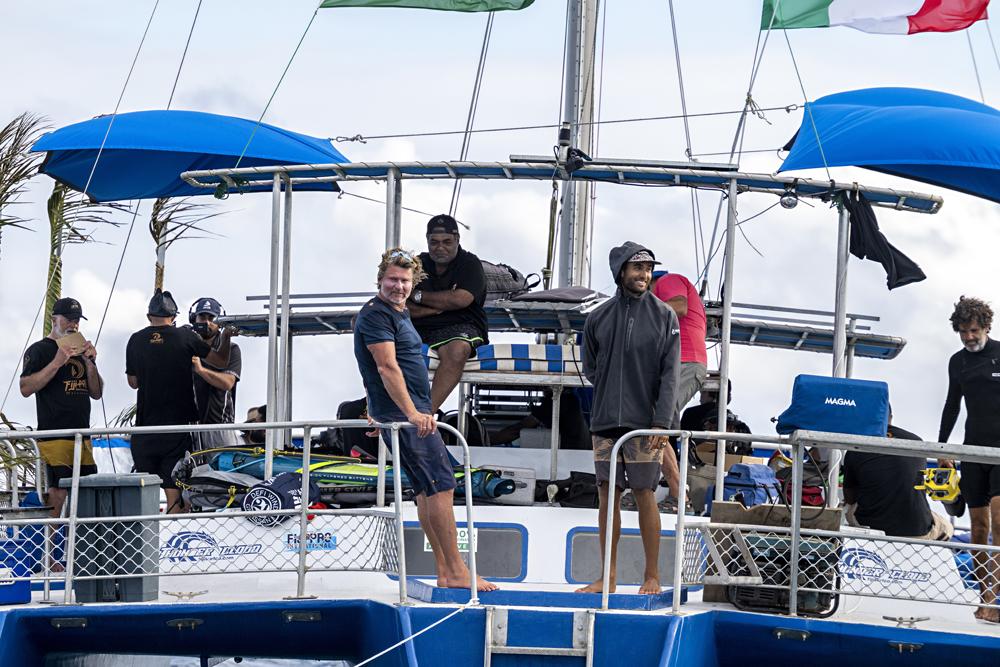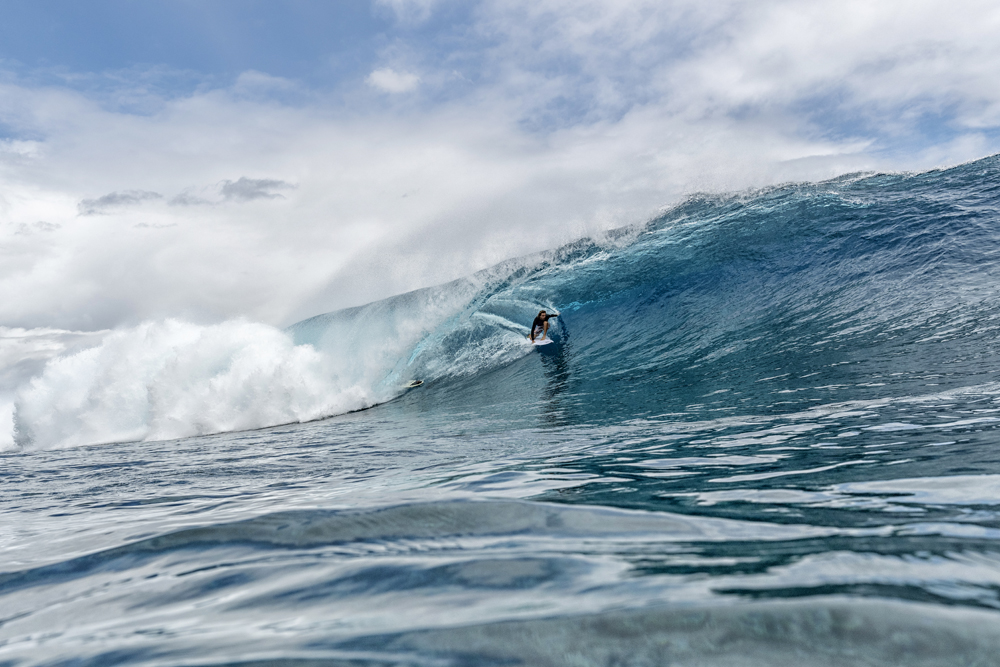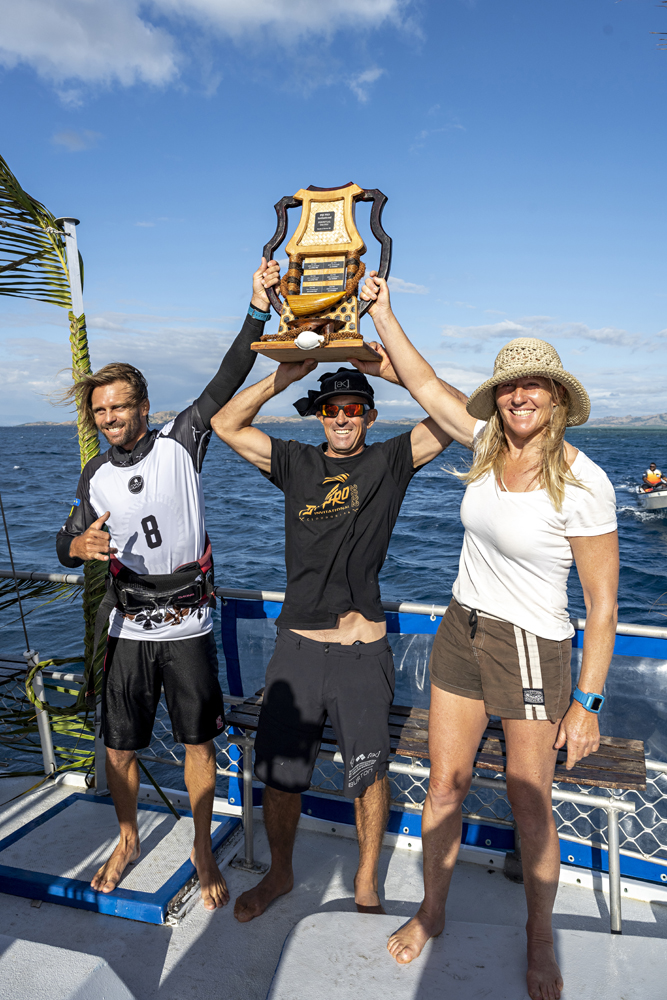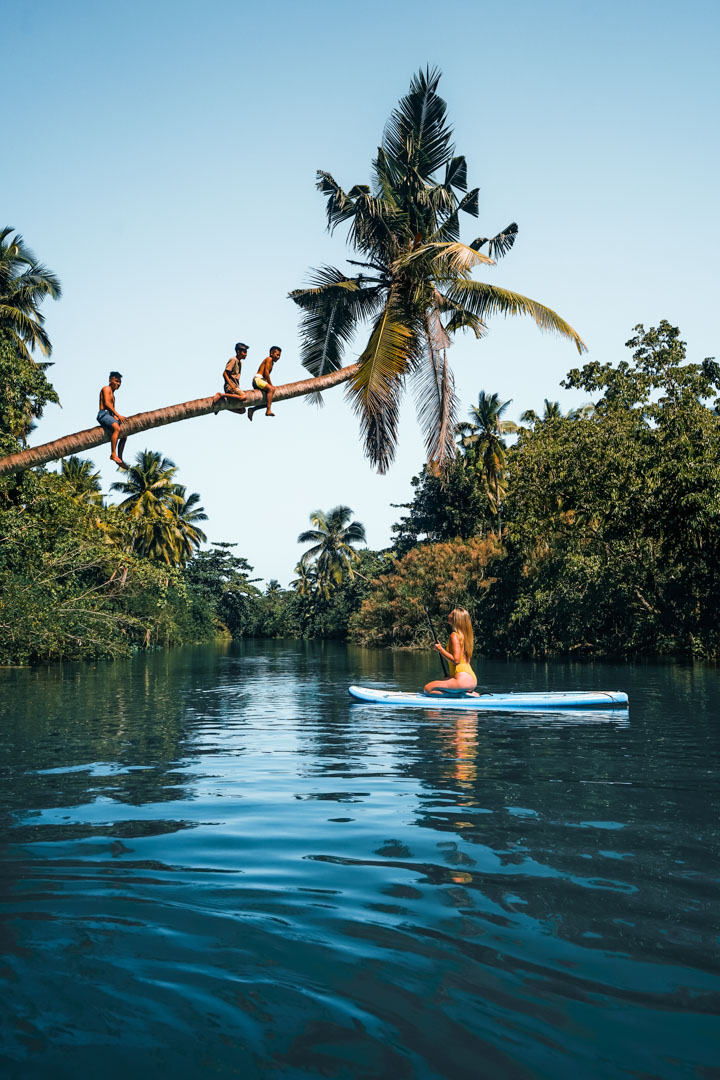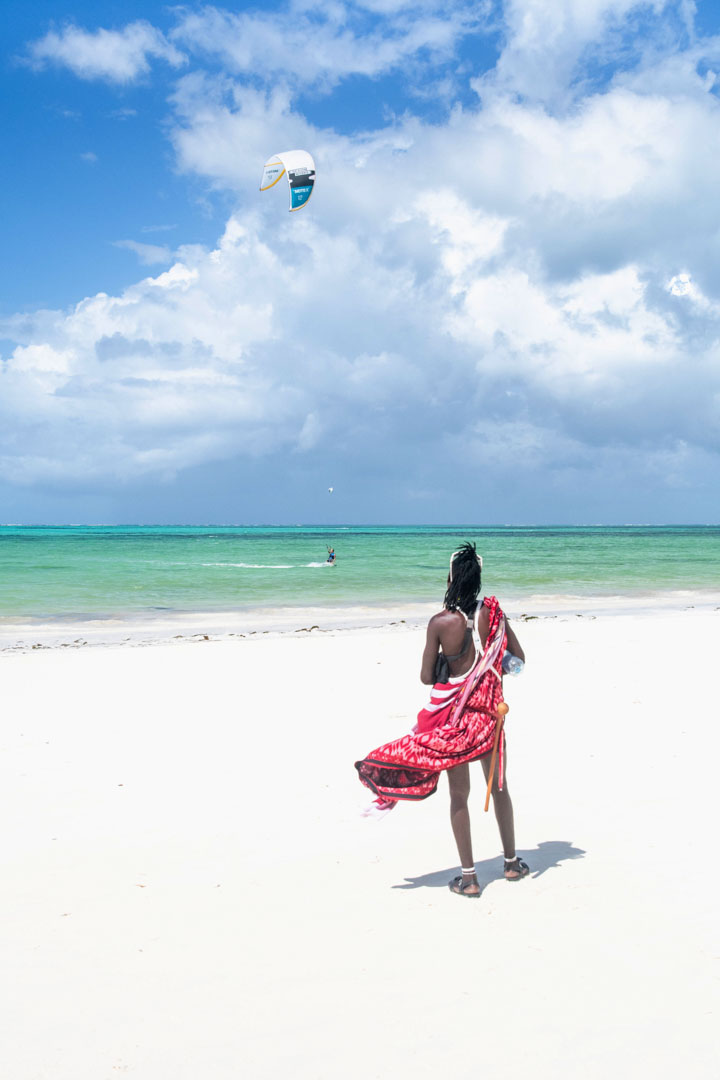ORIGINS (written by editor): In 1948, Sidney Newman Darby, 20, built the first small catamaran with a hand-held sail and rig mounted on a universal joint. Although he did not patent his invention, Darby is commonly seen as the father of sailboarding/windsurfing.
Later, in 1968, Henry Hoyle Schweitzer and Jim Drake received the first patent for a sailboard, calling their design a Windsurfer, and developed the sport to what became a phenomenon to some, a lifetime to many others. Founded in 2009 at Pistol River on the southern Oregon coast, the International Windsurfing Tour is today the single most prestigious windsurfing event title in the world.
THEN: Early Days
It’s a hopeful day for windsurfing. On a small gravel pull-off on Highway 101, vans, campers and rigs representing a caravan of wavesailors converging on the Oregon Coast begin to fill up the parking lot. Each individual looks out across pale dune embankments to the sea, and takes in the scattered monoliths and waves there. The winds are picking up as the land heats. Sails begin to crop up in the grasses leading out to the shore as each rider sets up his rig and tests it for feedback, the way a bird might feel the air with outstretched wings. Riders envision the way they might fly that day, and how things might change because of that flying.
We had all come for the inaugural 2009 Pistol River Wave Bash, held by the then newly formed American Windsurfing Tour. It was the first time in a long time that any competition had happened for wavesailors in this part of the world. A humble rebirth, ashes from which the phoenix hopes to rise. At least that’s the way I think of it now upon reflection. Here I stand today - some ten years later - witnessing a whole world of windsurfing experiences sprouting from that exact moment, with the winking eye of a Cloudbreak barrel peering out at me, and the wave’s tantalizing sea-spray lashes unfurling high into the air.
AND Now: IWT Fiji Pro at Cloudbreak
The wind is coming up. It’s a hopeful day for windsurfing, as a fleet of boats lies moored on the edge of the best wave in Fiji. Windsurfers wait together in the channel, watching the enormous barrels reeling through this immaculate reef-pass break. Like birds of prey, all eyes are focused ahead. Surveying. Shoulders forward. Ready. Each rider envisions the swooping turns and soaring airs they have come so far to find. I look ahead too, but feel that all I can see are the pale dunes from so long ago, lined with the feathers of hopeful windsurfers. How far since that time have they taken wing!
The IWT tour director, Simeon Glasson, announces over ship-to-ship radio that the competition will commence in less than an hour. Again the feathers of the windsurf flock bristle as if feeling the drafts being funneled through the margins between each hollow barrel. Windsurfing incorporates a sail fixed to a surfboard. It is a light craft, nimble in the waves, technical but robust, intuitive to learn and unlimited in its potential to articulate beautifully in the most intense elements our planet has to offer. The equipment is elegant as an albatross, and the people out there riding are shaped by their migratory wanderings.
Windsurfers scan the world’s oceans for conditions prime for their specialized version of hunting. All the factors involved in surfing are considered, plus more when the wind is taken into account. It just so happens that Cloudbreak in Fiji is a prime location for windsurfing. The direction, intensity and consistency of the wind, pairing with perfect waves, makes this place a dream for us. While many sailors have documented their exploits in these waters, it was really Camille Juban -one of our own International Windsurfing Tour riders- who came here and showcased this place as perfect for windsurfing.
While waiting in the channel at the start of the IWT Fiji Pro and preparing for my heat, I watched Camille sail into a set wave and drive a deep bottom turn under the lip of its growling monster end-bowl, that section where a surfer would be perfectly positioned for a massive barrel. He deliberately drew out his turn to stall for the perfect moment, his eyes unwaveringly fixed on the immediate lip. Camille luffed his sail long enough to allow the board room to carve vertically into the heavy lip, using the power of all that throwing water to form a perfect ramp. He reengaged his sail into the wind, lofted himself into a massive air that was twice the height of the squared-out tube that was now far below him. Sailing on the updraft from this cascading barrel, he transitioned from riding the wave with his rail to riding the wind with his sail. With all that speed generated, he cleared an entire section of the wave and landed firmly in the flats with enough energy to continue his ride before kicking out behind our boats in the channel. In that opening ride he showed knowledge of this wave, but also the kind of riding that is possible for a windsport drawing power from dual sources.
Each of us took in what Camille had just done, and set to work attempting to emulate it. Every rider has their own approach and brings their distinctive style to each wave. The points of difference are both subtle and beautiful. Robby Swift rode with a determined confidence and polish. He could’ve fooled anyone into believing he had years of experience at Cloudbreak when in reality he had only minutes. Nevertheless, Robby was the sailor we followed out beyond the reef and into deep water to search for sets. He managed to get himself into a massive set-wave, airing that bowl section in a way that was a little less critical than Camille’s approach, but arguably more powerful and definitely more picturesque.
Morgan Noireaux’ sail most likened that of a surfer, which is his wont and his “M.O.”. No one seemed to understand the wave better, what it needed and in what places to apply it. I didn’t see a single off-beat turn from him, and the result was extremely memorable. He didn’t break a single piece of kit, a feat in and of itself for a finalist.
I remember flying to Oregon in those early days was a harrowing experience in and of itself. Getting on a plane out of Maui, it crossed from the North to the South of all that I had known in five minutes. The world turned beneath the plane’s jets and over the vast Pacific as we went through the night. In the morning we were transported from a world of warmth and sunshine to a place older, grayer, colder and infinitely less hospitable. I feared the unknown, but I had my windsurfing gear which meant that at least one thing would be familiar and fun! I tried to visualize whatever was down there along the Oregon ocean and reduced it to being something like Maui. At that moment sailing became my home.
In the same way, I feared the unknowns of this Cloudbreak wave which the Fijian tribe of the Nabilla village know as Kurukuru Mailani or Thunder from the Heavens. The sound of the wave is visceral and is as much a part of its living being as the feathering wind texture and chatter on its face, or the speed at which it heaves itself over a shallow reef like a hammer onto an anvil. The gnarl and bite of that reef leaves red tattoos on riders since it is alive with razor corals. I dropped into my first wave on the sounding of the start horn for my first heat of the IWT Fiji Pro. There was easily a football field’s distance between me and the nearest channel-moored boat, an area that seemed to widen as the swell grew taller and more vertical over the reef. I was faced with one hundred meters of wave I did not yet know, apart from a few warm up SUP sessions earlier in the week. But I was home. I was sailing.
I realized that wavesailing felt so good to me because it was one of the few water sport activities that I could visualize myself doing anywhere, anytime. My first turns on the legendary Cloudbreak wave were… remembered, predestined. They felt good! Two turns into the open face of a long wall and the bowl began to form ahead of me. I set up for it the way I had seen Camille do. Part of me held my breath for fear of remembering what had happened to me in the Marshall Islands. The rest of me luffed the sail, envisioning the way I might fly that day, and how things might change because of that flying. In one heaving motion the lip projected me and I pulled my sail in close to feel the new power filling it. I was aloft like never before in any other wavesailing session. The feeling of the sport changed as this feather of mine filled with the dynamic wind of this mythical wave’s making. Thunder rolled below me as I fell from Mailani, back into the embrace of a cloud break, a dream wave that continued on, ending in the channel.
How much better I understand wavesailing from that single wave. It represented everything that wavesailing means to me, the place it has in my life. It is a hologram for home I always carry with me, my map to unknown worlds and new experiences.
Life changes when perspective changes. The previously unknown, when explored, renders the known. A person’s experiences grow with every passing day while the awareness of what is mysterious also expands, so that the balance is never tipped between the seen and unseen. Through time and trial, we can circumnavigate from the familiar to circle out around the strange, only to come back to things unchanged. That is the fundamental nature of travel, and of sailing, and all adventure. To become lost and go way out on the edge of tomorrow only to confront where you have been from a perspective of the place you never dreamed you could go.
I think about the first Europeans to have sailed to Fiji. Captain Cook and his crew who cast their fortunes to this phenomenological wheel of exploration and change. They are remembered for mapping the unknown world and making it known. But that part of the world was known already by those who lived there. They made it known to themselves and therefore expanded their understanding of it and themselves. I believe that those brave sailors recorded the experience of being alive. Their journeys are a map to living with uncertainty. Their mistakes and shortcomings are both a key and legend to a life with no answers, only lessons and changing perspective. The retrospective feeling that Fiji gave me is going to shape the way I see the things I love, the importance I place on certain elements of my life, and how I choose to navigate the future. Getting that perspective shift is the only goal for going out the door on any given day, I think.
As the day grew to a close at Cloudbreak, it was down to Camille, Robby, Morgan and myself in the finals. The semifinal was in its dying minutes when the wind began to soften. At this point, most other sailors had broken sails or boards, and were languishing on the reef out of contention. Robby Swift and I held our positions in the lineup, now jockeying for the last set to come through in that heat, just playing for 1st and 2nd place between ourselves. As we pushed each other to reach further up the reef, lines of swell started to materialize on the horizon and we were quickly climbing waves into the heart of the set. However, the wind was siphoning away slowly as Robby and I both made unsuccessful bids for a wave. Then, all at once, the last waves of that final set rolled beneath us.
We could barely stand and the surrounding break was still and glassy. As competitors we made a vague show of holding positions and playing priority; but we both knew we were powerless to catch anything. After another minute, Robby and I looked at each other, looked upwind, looked at our watches. Robby shouted to me, “We’re gonna surf in like 5 minutes!” Riders don’t waste waves. And in less than five minutes we had slogged back to our support boats, ditched windsurf gear, fished out our surfboards from beneath a mountain of gear bags and jumped back into the water. Support skis drove us into the takeoff zone. From competitors to friends, we surfed a still and breathless double-overhead Cloudbreak until the sun dipped below the horizon in breathtaking majesty.
All of us are ultimately seekers of beauty. We want to dress up a beautiful day by calling it “epic”, using words like “ripping” or “firing”, but really we are describing (or attempting to convey) the perfect aesthetic experience. The windsurf trip is an adventure novel and a romance with the sea. What I love so much about this group of readers is that none of us have claimed the role of main character. That spot is reserved for Kurukuru Mailani, Thunder from the Heavens, this beautiful wave that expressed so many of her moods, and that took us on a journey.
Every windsurfer here has read the novel Cloudbreak in zealous haste and each has his own summary. Parts when the waves were big and terrifying, epic tales of when gear was cracked and rend asunder. Lovely moments of bliss in heavenly tubes of glassy texture, the tones of beautiful sunsets providing romantic backdrops for surfers and windsurfing alike. We all agree that we eagerly anticipate the sequel, and look forward to meeting up again next year to catch up, rig up, and be changed again by this amazing sport called windsurfing.
Author’s Side Note:
On a side note, there is a lot more to traveling and sailing than just the selfish self-exploratory sensations. While in Fiji, we met up with some really stoked kids and shared some gear and tips on how to use it. This is something we, as windsurfers, want to continue to pass on in respect for all the wonderful moments experienced through this sport. So in partnership with Fiji Surf Co. , I’m opening a watersports clinic to get Fijians out sailing, surfing, and SUPing. This clinic will be starting on the island of Viti Levu and moving across the many rural islands of Fiji. If you would like to make a donation to this effort of facilitating fun, (whether it be waterwear, spares, or fixer-upper repairs) please let me know! The Fiji Gear Drive is in full swing.


